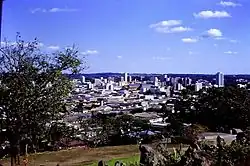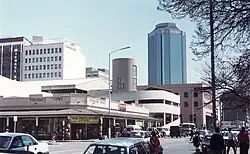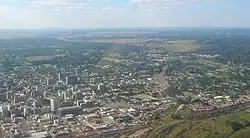Timeline of Harare
The following is a timeline of the history of the city of Harare, Zimbabwe.
Prior to 20th century
| History of Zimbabwe | ||||||||||||||||||||||||||||||||||||||||||
|---|---|---|---|---|---|---|---|---|---|---|---|---|---|---|---|---|---|---|---|---|---|---|---|---|---|---|---|---|---|---|---|---|---|---|---|---|---|---|---|---|---|---|
 | ||||||||||||||||||||||||||||||||||||||||||
Ancient history
|
||||||||||||||||||||||||||||||||||||||||||
White settlement pre-1923
|
||||||||||||||||||||||||||||||||||||||||||
- 1890 – Fort Salisbury founded in Mashonaland by British South Africa Company.[1]
- 1891 – Mashonaland Herald and Zambesian Times newspaper begins publication.[2]
- 1896 – Salisbury Polo Club formed.
- 1897
- Harare Township built.[1]
- Salisbury attains municipal status.[1]
- 1899 – Beira-Salisbury railway begins operating.[1][3]
20th century
- 1902
- 1915 – Meikles Hotel in business.
- 1923 – Town becomes capital of Southern Rhodesia,[5] a self-governing British colony.
- 1927 – Salisbury Technical School established.[1]
- 1933 – Town House built.[6]
- 1936 – Library of the National Archives founded.[7]
- 1939 – Honorary Consulate of Poland opened.[8]
- 1945 – Railway strike.[9]
- 1946
- 1948
- 1950 – Gwebe College of Agriculture established.[1]
- 1951
- Stock exchange established.
- Population: 90,024.[11]
- 1953
- City becomes capital of the Federation of Rhodesia and Nyasaland.
- Helping Hand Club (women's group) formed.[12]
- 1955 – University College of Rhodesia and Nyasaland and Salisbury City Youth League[13] established.
- 1956
- Salisbury Airport commissioned.
- Bus boycott.[14]
- 1957 – Rhodes National Gallery opens.[15][16]
- 1959 – Pearl Assurance House built.
- 1960 – Central Film Laboratories in business.[17]
- 1962
- 1964 – Greenwood Park established.[6]
- 1969 – The Financial Gazette begins publication.

- 1970 – Chapungu Sculpture Park founded.[6]
- 1972
- Zimbabwe National Library and Documentation Service headquartered in city.[7]
- Construction of New Mabvuku begins.
- 1973 - Population: 502,000 urban agglomeration.[19]
- 1975 – Mabvuku High School opens in Mabvuku.
- 1977 – 6 August: Bombing.
- 1978 – Oil storage tanks set on fire by the Zimbabwe African National Liberation Army.[20]
1980s–1990s
- 1980 18 April: City becomes part of independent Republic of Zimbabwe.
- 1981
- December: Bombing of ZANU-PF headquarters.[21]
- National Heroes' Acre monument built near city.[22]
- 1982 18 April: City renamed "Harare."[23]
- 1984 – Harare Publishing House established.[24]
- 1985 – Karigamombe Centre built.
- 1986 – September: City hosts Summit of the Non-Aligned Movement.

- 1990
- Sister city relationship established with Cincinnati, US.[25]
- ZANU–PF Building is completed
- 1991 – October: City hosts Commonwealth Heads of Government Meeting 1991; Harare Declaration issued.
- 1992 - Population: 1,189,103.[26]
- 1995 – September: City hosts 1995 All-Africa Games.
- 1996
- 1997 – New Reserve Bank tower built.
- 1998
- Weaver Press publishing house established
- Economic protest.[30]
- Zimbabwe International Film Festival begins.
- December: City hosts meeting of World Council of Churches.
- 1999
- Daily News begins publication.
- Zimbabwe Catholic University established.
- Harare International Festival of the Arts begins.
- Media Monitoring Project headquartered in city.[31]
- 2000 – Millennium Towers built.
21st century

2000s
- 2001 – Harare Tribune newspaper begins publication.
- 2002 – Elias Mudzuri becomes mayor.[32][33]
- 2003
- Water shortage.[34]
- Sekesai Makwavarara becomes acting mayor.[35]
- 2004 – Harare International Airport terminal built (approximate date).
- 2005 – Operation Murambatsvina.[33]
- 2008
- Emmanuel Chiroto elected mayor, succeeded by Muchadeyi Masunda.[36]
- Harare Residents Trust organised.[37]
- Cholera outbreak.
- 2009
- First Floor Gallery Harare in business.
- Population: 1,513,173.[38]
2010s
- 2010
- 2012 - Population: 1,485,231.[41]
- 2013 - Bernard Gabriel Manyenyeni becomes mayor.[42]
- 2017 - The military of Zimbabwe seize power and place the president under house arrest.
See also
References
- ^ a b c d e f g h Mlambo 2003.
- ^ "Harare (Zimbabwe) Newspapers". WorldCat. US: Online Computer Library Center. Retrieved 15 May 2013.
- ^ "Rhodesia", Encyclopedia Americana, NY: Encyclopedia Americana Corp., 1919
- ^ Robert Wedgeworth, ed. (1993), "Zimbabwe", World encyclopedia of library and information services, US: American Library Association, ISBN 0838906095
- ^ Owomoyela 2002.
- ^ a b c "Sight Seeing in Harare". City of Harare. Archived from the original on 18 August 2013. Retrieved 15 May 2013.
- ^ a b World Guide to Libraries (25th ed.), De Gruyter Saur, 2011, ISBN 9783110230710
- ^ Ceranka, Paweł; Szczepanik, Krzysztof (2020). Urzędy konsularne Rzeczypospolitej Polskiej 1918–1945. Informator archiwalny (in Polish). Warszawa: Naczelna Dyrekcja Archiwów Państwowych, Ministerstwo Spraw Zagranicznych. p. 342. ISBN 978-83-65681-93-5.
- ^ Kenneth P. Vickery (1998). "The Rhodesia Railways African Strike of 1945, Part I: A Narrative Account". Journal of Southern African Studies. 24 (3): 545–560. doi:10.1080/03057079808708589. JSTOR 2637660.
- ^ a b Terence Ranger (1985), Peasant consciousness and guerilla war in Zimbabwe, London: Currey, ISBN 0852550006
- ^ a b "Population of capital city and cities of 100,000 or more inhabitants". Demographic Yearbook 1955. New York: Statistical Office of the United Nations.
- ^ Michael Oliver West (2002). The Rise of an African Middle Class: Colonial Zimbabwe, 1898 – 1965. Indiana University Press. ISBN 0253215242.
- ^ Timothy Scarnecchia (2008), The urban roots of democracy and political violence in Zimbabwe, University of Rochester Press, ISBN 9781580462815
- ^ Scarnecchia 1996.
- ^ "History". National Gallery of Zimbabwe. Archived from the original on 7 July 2013. Retrieved 15 May 2013.
- ^ a b "Southern Africa, 1900 A.D.–present: Key Events". Heilbrunn Timeline of Art History. New York: Metropolitan Museum of Art. Retrieved 30 August 2015.
- ^ Katrina Daly Thompson (2013), Zimbabwe's cinematic arts, Bloomington: Indiana University Press, ISBN 9780253006462
- ^ About Us, Harare City Library, retrieved 30 September 2014
- ^ United Nations Department of Economic and Social Affairs, Statistical Office (1976). "Population of capital city and cities of 100,000 and more inhabitants". Demographic Yearbook 1975. New York. pp. 253–279.
Salisbury
{{cite book}}: CS1 maint: location missing publisher (link) - ^ Brian Raftopoulos and Alois Mlambo, ed. (2009), Becoming Zimbabwe, Harare: Weaver Press, ISBN 9781779220837
- ^ Andrew Norman (2004), Robert Mugabe and the betrayal of Zimbabwe, Jefferson, N.C: McFarland Publishers, ISBN 0786416866
- ^ Historical Buildings, City of Harare, archived from the original on 31 August 2015
- ^ "Zimbabwe's capital to be renamed Harare". The New York Times. 19 April 1982.
- ^ "Zimbabwe: Directory". Africa South of the Sahara 2004. Regional Surveys of the World. Europa Publications. 2004. ISBN 1857431839.
- ^ "Cincinnati USA Sister City Association". US. Archived from the original on 19 May 2013.
- ^ "Population of capital cities and cities of 100,000 and more inhabitants". 1995 Demographic Yearbook. New York: United Nations Department for Economic and Social Information and Policy Analysis, Statistics Division. 1997. pp. 262–321.
- ^ "Movie Theaters in Harare, Zimbabwe". CinemaTreasures.org. Los Angeles: Cinema Treasures LLC. Retrieved 15 May 2013.
- ^ ArchNet. "Harare". US: MIT School of Architecture and Planning. Archived from the original on 7 October 2012.
- ^ "Women Filmmakers of Zimbabwe". Women's Coalition of Zimbabwe. Archived from the original on 7 September 2015. Retrieved 15 May 2013.
- ^ Alois S. Mlambo (2014). "Timeline". History of Zimbabwe. Cambridge University Press. ISBN 978-1-107-02170-9.
- ^ "Organizational Profile". Harare: Media Monitoring Project. Archived from the original on 11 March 2012.
- ^ "Demise of Herare". The Financial Gazette. 13 February 2013.
- ^ a b Jon Lee Anderson (27 October 2008). "Letter from Zimbabwe". The New Yorker.
- ^ Kwame Anthony Appiah and Henry Louis Gates, ed. (2005). "Harare, Zimbabwe". Africana: The Encyclopedia of the African and African American Experience (2nd ed.). Oxford University Press. ISBN 978-0-19-517055-9.
- ^ Kamete 2006.
- ^ "His Worship the Mayor". City of Harare. Archived from the original on 15 May 2013.
- ^ "Profiles: Harare Residents' Trust Board of Trustees". The Zimbabwean. UK. 29 August 2012. Archived from the original on 28 June 2013.
- ^ "Population of capital cities and cities of 100,000 or more inhabitants". Demographic Yearbook 2011. United Nations Statistics Division. 2012.
- ^ Karen Fung, African Studies Association (ed.). "Zimbabwe Newspapers and News on the Internet". Africa South of the Sahara. US. Retrieved 15 May 2013 – via Stanford University.
- ^ "Zimbabwe Fashion Week getting better", The Standard, 8 September 2013
- ^ "Table 8 - Population of capital cities and cities of 100,000 or more inhabitants", Demographic Yearbook – 2018, United Nations
- ^ "Mayor". City of Harare. Archived from the original on 31 August 2015.
Bibliography
Published in 20th century
- Neil Dewar (1991). "Harare". In Anthony Lemon (ed.). Homes Apart: South Africa's Segregated Cities. Indiana University Press. ISBN 0-253-33321-0.
- Terri Barnes; Everjoice Win (1992), To live a better life: an oral history of women in the city of Harare, 1930–70, Harare, Zimbabwe: Baobab Books, ISBN 0908311354
- Carole Rakodi (1995), Harare: Inheriting a Settler-Colonial City; Change or Continuity?, John Wiley & Sons, ISBN 9780471949510
- Nelson T. Samburenia (1996). "Emergence of independent African trade unions in Salisbury, Southern Rhodesia, 1920s to 1950s: Toward mass nationalism?". Kleio. 28.
- Timothy Scarnecchia (1996). "Poor Women and Nationalist Politics: Alliances and Fissures in the Formation of a Nationalist Political Movement in Salisbury, Rhodesia, 1950-6". Journal of African History. 37 (2): 283–310. doi:10.1017/S0021853700035234. JSTOR 183187. S2CID 162454994.
- Kinuthia Macharia (1997). Social and political dynamics of the informal economy in African cities: Nairobi and Harare. University Press of America. ISBN 978-0-7618-0840-4.
- Teresa A. Barnes (1999), 'We Women Worked so Hard': Gender, Urbanization and Social Reproduction in Colonial Harare, Zimbabwe, 1930–1956, Heinemann, ISBN 9780325001739
- Patrick Bond (1999). "Capital in the city: a history of urban financialflows through colonial Harare". In Brian Raftopoulos and Tsuneo Yoshikuni (ed.). Sites of Struggle. Weaver Press Ltd. ISBN 0797419845.
Published in 21st century
- Governing the Poor in Harare, Zimbabwe, Sweden: Nordic Africa Institute, 2002 – via International Relations and Security Network
- Oyekan Owomoyela (2002). "Introduction: Cities: Harare". Culture and Customs of Zimbabwe. Greenwood. p. 7+. ISBN 978-0-313-31583-1.
- Stanley D. Brunn; et al., eds. (2003), "Harare", Cities of the World (3rd ed.), Rowman & Littlefield, ISBN 084769898X
- Alois Mlambo (2003). "Harare". In Dickson Eyoh and Paul Tiyambe Zeleza (ed.). Encyclopedia of Twentieth-Century African History. Routledge. ISBN 0415234794.
- Luc J. A. Mougeot, ed. (2005). "(Harare)". Agropolis: The Social, Political, and Environmental Dimensions of Urban Agriculture. International Development Research Centre. ISBN 978-1-55250-186-3.
- Kevin Shillington, ed. (2005). "Harare". Encyclopedia of African History. Fitzroy Dearborn. ISBN 978-1-57958-245-6.
- Amin Y. Kamete (2006). "The Return of the Jettisoned: ZANU-PF's Crack at 'Re-Urbanising' in Harare". Journal of Southern African Studies. 32 (2): 255–271. Bibcode:2006JSAfS..32..255K. doi:10.1080/03057070600656143. JSTOR 25065091. S2CID 153859378.
- Terence O. Ranger (2007). "City Versus State in Zimbabwe: Colonial Antecedents of the Current Crisis". Journal of Eastern African Studies. 1 (2): 161–192. doi:10.1080/17531050701452390. S2CID 154586516.
 (Includes information about Harare)
(Includes information about Harare) - Innocent Chirisa (28 November 2012), "Social Capital Dynamics in the Post-colonial Harare Urbanscape", in Joseph D. Lewandowski and Gregory W. Streich (ed.), Urban social capital, Burlington, VT: Ashgate (published 2011), p. 199+, ISBN 9781409412243
External links
Wikimedia Commons has media related to History of Harare.
- "(Harare)". Directory of Open Access Journals. UK. (Bibliography of open access
 articles)
articles) - "(Harare)" – via Europeana. (Images, etc.)
- "(Harare)" – via Digital Public Library of America. (Images, etc.)
- "(Harare)". Internet Library Sub-Saharan Africa. Germany: Frankfurt University Library. (Bibliography)
- "(Harare)". Connecting-Africa. Leiden, Netherlands: African Studies Centre. (Bibliography)
- "(Harare)". AfricaBib.org. (Bibliography)
- "Harare, Zimbabwe". BlackPast.org. US. 8 October 2014.
Images
-
.jpg) International Summit of the Non-Aligned Movement, held in Harare in 1986
International Summit of the Non-Aligned Movement, held in Harare in 1986 -
![Africa Unity Square [sn], 1992](./_assets_/Harare_Africa_Unity_1992.jpg) Africa Unity Square, 1992
Africa Unity Square, 1992